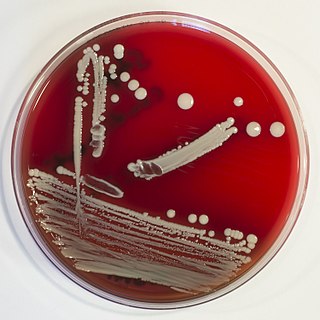Staphylococcus hominis is a coagulase-negative member of the bacterial genus Staphylococcus, consisting of Gram-positive, spherical cells in clusters. It occurs very commonly as a harmless commensal on human and animal skin and is known for producing thioalcohol compounds that contribute to body odour. Like many other coagulase-negative staphylococci, S. hominis may occasionally cause infection in patients whose immune systems are compromised, for example by chemotherapy or predisposing illness.

Staphylococcus is a genus of Gram-positive bacteria in the family Staphylococcaceae from the order Bacillales. Under the microscope, they appear spherical (cocci), and form in grape-like clusters. Staphylococcus species are facultative anaerobic organisms.
Staphylococcus succinus is a Gram-positive coccoid bacterium belonging to the genus Staphylococcus.

Staphylococcus condimenti is a Gram-positive, coagulase-negative member of the bacterial genus Staphylococcus consisting of single, paired, and clustered cocci. Strains of this species were originally isolated from fermenting soy sauce mash and are positive for catalase, urease, arginine dihydrolase, nitrate reductase, beta-galactosidase, and phosphatase activity.
Staphylococcus vitulinus is a Gram-positive, coagulase-negative member of the bacterial genus Staphylococcus consisting of clustered cocci. The species was originally isolated from food and animals and was named Staphylococcus vitulus. The name was later changed to Staphylococcus vitulinus for correct Latin grammar.
Staphylococcus stepanovicii is a Gram-positive, coagulase-negative member of the bacterial genus Staphylococcus consisting of single, paired, and clustered cocci. The species is novobiocin-resistant and oxidase-positive. It was named in honor of Serbian microbiologist Srdjan Stepanović.
Staphylococcus arlettae is a gram-positive, coagulase-negative member of the bacterial genus Staphylococcus consisting of clustered cocci. It has been isolated from the skin of mammals and birds and is novobiocin resistant. A strain of this species isolated from effluent from a textile factory was found to be able to degrade azo dyes.
Staphylococcus simiae is a Gram-positive, coagulase-negative member of the bacterial genus Staphylococcus consisting of clustered cocci. This species was originally isolated from the gastrointestinal tract of South American squirrel monkeys, Saimiri sciureus, and found to be genetically similar to S. aureus, but more biochemically similar to S. piscifermentans. A draft genome of S. simiae was sequenced.
Staphylococcus carnosus is a Gram-positive, coagulase-negative member of the bacterial genus Staphylococcus consisting of single and paired cocci. Its genome has the highest GC content - 36.4% - of any sequenced staphylococcal species.
Staphylococcus rostri is a Gram-positive, coagulase-negative member of the bacterial genus Staphylococcus consisting of clustered cocci. This species was originally isolated from the noses of healthy pigs; the name is derived from the Latin rostrum or "the snout of a swine".
Staphylococcus microti is a Gram-positive, coagulase-negative member of the bacterial genus Staphylococcus consisting of clustered cocci. This species was originally isolated from viscera of the common vole, Microtus arvalis. It is genetically similar to Staphylococcus rostri.
Staphylococcus lentus is a Gram-positive, oxidase-positive, coagulase-negative member of the bacterial genus Staphylococcus consisting of clustered cocci. The species was originally classified as a subspecies; its name is a combination derived from Staphylococcus sciuri subsp. lentus.
Staphylococcus sciuri is a Gram-positive, oxidase-positive, coagulase-negative member of the bacterial genus Staphylococcus consisting of clustered cocci. The type subspecies S. sciuri subsp. sciuri was originally used to categorize 35 strains shown to use cellobiose, galactose, sucrose, and glycerol.
Staphylococcus delphini is a Gram-positive, coagulase-positive member of the bacterial genus Staphylococcus consisting of single, paired, and clustered cocci. Strains of this species were originally isolated from aquarium-raised dolphins suffering from skin lesions.
Staphylococcus fleurettii is a Gram-positive, coagulase-negative member of the bacterial genus Staphylococcus consisting of single, paired, and clustered cocci. Strains of this species were originally isolated from raw-milk goat cheese.
Staphylococcus devriesei is a Gram-positive, coagulase-negative member of the bacterial genus Staphylococcus consisting of clustered cocci. It was originally isolated from cow's milk and teats, and on the basis of 16S ribosomal RNA sequence, is most genetically similar to S. haemolyticus, S. hominis, and S. lugdunensis. More recent studies have found the species on cow teat skin, but not commonly in milk, suggesting this commensal bacterium does not generally flow into milk.
Staphylococcus massiliensis is a Gram-positive, coagulase-negative member of the bacterial genus Staphylococcus consisting of clustered cocci. Strains of this species were first isolated from a human brain abscess and were found to be most closely related to Staphylococcus piscifermentans, Staphylococcus condimenti, Staphylococcus carnosus subsp. carnosus, Staphylococcus carnosus subsp. utilis, and Staphylococcus simulans. A subsequent study found that S. massiliensis may actually be part of the human skin microbiome and may have been a contaminant of brain abscess-derived samples.
Staphylococcus piscifermentans is a Gram-positive, coagulase-negative member of the bacterial genus Staphylococcus consisting of clustered cocci. This species was originally isolated from fermented fish in Thailand. A later study found a strain of S. piscifermentans in dog feces. The species is used in the preparation of fermented foods along with Staphylococcus carnosus; both species reduce nitrate and produce ammonia.
Staphylococcus kloosii in a gram-positive, coagulase-negative member of the bacterial genus Staphylococcus consisting of single, paired, and clustered cocci. Strains of this species were originally isolated from and among the most frequent constituents of normal skin flora and various wild animals.
Staphylococcus agnetis is a Gram positive, coagulase-variable member of the bacterial genus Staphylococcus. Strains of this species were originally isolated from the milk and teats of cows with mastitis. This species is not known to infect humans.

